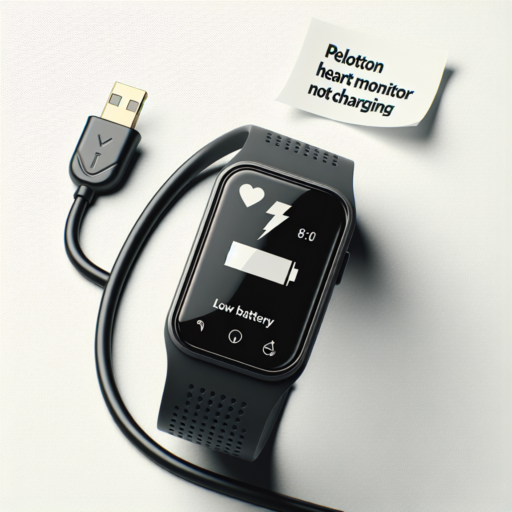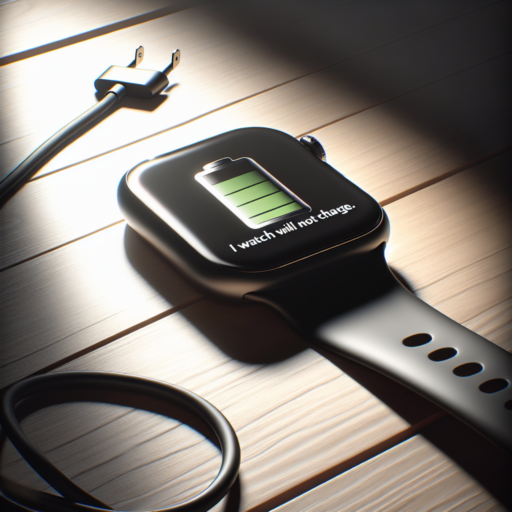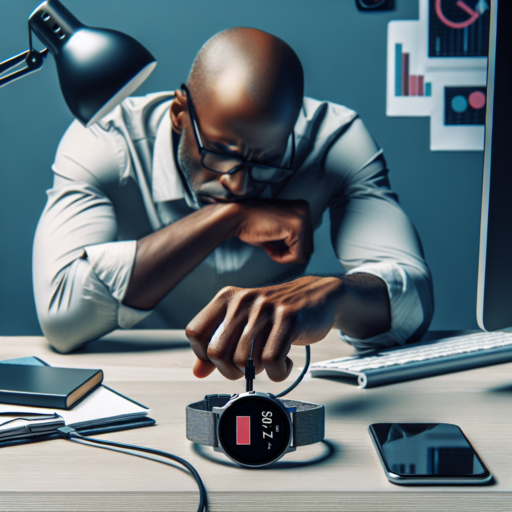Understanding the Basics: Why Your Watch Won’t Charge
When it comes to wearable technology, a common frustration among many users is encountering issues with their device not charging properly. Understanding why your watch won’t charge is essential for resolving the issue and getting back to utilizing your gadget to its fullest potential. In this article, we’ll dive into some of the fundamental reasons behind charging issues and how to identify them.
First and foremost, it’s crucial to inspect the charging cable and adapter. A faulty charger can often be the culprit behind your watch failing to charge. Check for any visible signs of damage, such as frays or cuts in the cable, or if the adapter is not correctly plugged into the power outlet. Additionally, ensuring that the charging contacts on both the cable and your watch are clean is key. Over time, dirt and debris can accumulate, obstructing the connection needed to charge your watch effectively.
Possible Obstructions to Charging
- Magnetic fields: Sometimes, the presence of other electronic devices can create a magnetic field that interferes with the charging process.
- Software glitches: Occasionally, a software update can disrupt the normal functioning of your watch, including its ability to charge.
- Hardware issues: Physical damage to the watch itself, like water damage or a broken charging port, can prevent the watch from charging.
Addressing these core aspects can significantly enhance your troubleshooting process, making it easier to determine why your watch won’t charge. Remember, diagnosing the problem accurately is the first step towards a solution.
Common Reasons Your Watch Is Not Charging
Encountering issues with your watch not charging can be frustrating. Understanding the common reasons behind this inconvenience can help you troubleshoot and potentially resolve the issue without needing professional intervention. Below, we delve into some of the most frequent culprits that might be affecting your watch’s ability to charge.
Damaged Charging Cable or Adapter
One of the most overlooked yet common reasons for a watch not charging is a damaged charging cable or adapter. Over time, wear and tear can cause the cable to fray, bend, or even break internally, disrupting the connection needed to charge your watch. Similarly, adapters can suffer from internal damage or connectivity issues. It’s essential to inspect these components closely for any signs of damage or to try charging with an alternate cable or adapter to diagnose the problem.
Dirty or Obstructed Charging Contacts
Another significant issue that can prevent your watch from charging is dirty or obstructed charging contacts. Dust, lint, and other debris can accumulate over time, hindering the connection between your watch and its charging dock or cable. Ensuring that both the watch’s charging contacts and the corresponding charger are clean and free of obstructions is crucial for effective charging. Using a soft, dry cloth to gently wipe away any debris can make a significant difference.
Software Issues
Although less common, software issues can also contribute to your watch not charging properly. Glitches within the operating system or firmware can cause the watch to fail to recognize when it’s placed on the charger or interrupt the charging process. In some cases, a simple restart of the watch can resolve these software glitches. For more persistent issues, looking into software updates or a factory reset (after backing up important data) may be necessitated.
No se han encontrado productos.
How to Properly Clean Your Watch and Charging Dock
Cleaning your watch and charging dock not only keeps them looking pristine but also ensures their longevity and functionality. Over time, grime and bacteria can accumulate, potentially hindering the device’s charging capability and causing skin irritations. It’s crucial to follow a precise and safe cleaning method to avoid damage.
Step-by-Step Cleaning Guide for Your Watch
Begin by powering off your watch and removing it from the charging dock. If your watch is water-resistant, lightly dampen a microfiber cloth with water and a tiny bit of mild soap. Gently wipe the surface and the straps, paying extra attention to crevices where dirt can accumulate. If the watch has a leather band, avoid using water and opt for specialized leather cleaner instead. After cleaning, use another dry microfiber cloth to remove any moisture or residue.
Keeping the Charging Dock in Top Shape
The charging dock, though often overlooked, requires regular cleaning to maintain its performance. Start by unplugging the dock and using a dry toothbrush or a can of compressed air to remove any visible dust or debris from the connection port. For a deeper clean, slightly dampen a cotton swab with rubbing alcohol and gently clean around the port area, being careful not to allow any liquid to get inside. Wipe the exterior with a dry cloth, ensuring the dock is completely dry before plugging it back in.
Reminder: Always consult your device’s manual before cleaning to prevent any unintentional damage. Different materials may require specific cleaning agents and methods. Regular maintenance keeps your watch and charging dock in optimal condition, ensuring they serve you well into the future.
Compatibility Issues That Prevent Charging
When it comes to keeping our devices powered up, encountering compatibility issues can be a major hindrance. These issues often arise due to mismatches between the charging cable, the power adapter, and the device itself. Understanding the root cause of these compatibility problems is essential to ensure your device charges efficiently and remains ready for use.
Outdated Charging Standards: One common issue stems from the rapid evolution of charging technology. Devices and chargers manufactured a few years ago may not be compatible with the latest standards, such as USB-C or Qualcomm’s Quick Charge. This discrepancy can lead to slow charging speeds or, in some cases, prevent charging altogether. It’s important to verify that your charger and device support the same charging protocols to avoid these issues.
Cable Quality and Type: Not all cables are created equal. The quality and type of charging cable used can significantly impact compatibility. Low-quality or damaged cables may not have the capacity to handle the power requirements of your device, leading to inefficient charging or no charging at a time. Additionally, certain devices require specific cable types, such as Lightning cables for Apple products or micro-USB for many Android devices, to charge correctly. Using the correct type and quality of cable is crucial for avoiding compatibility issues.
Troubleshooting Tips for Charging Your Watch
Experiencing issues with charging your watch can be frustrating. However, before you consider a visit to the repair shop, there are several troubleshooting tips you can attempt at home. These simple steps might help revive your watch’s charging capabilities and ensure you’re back to tracking time without a hitch.
Ensure the Charging Dock is Properly Connected
Often, charging issues stem from the charging dock or cable not being properly connected. First, verify that the cable is securely plugged into both your watch and the power source. It’s crucial to use the original charging equipment that came with your watch, as third-party cables may not be compatible or could cause further issues. Additionally, inspect the charging dock and cable for any visible damages, which could be the culprit behind the charging woes.
Check the Power Source
Another common oversight is the power source itself. Whether you’re using a wall charger, a computer USB port, or a power bank, ensure that the power source is turned on and functioning properly. Trying a different wall outlet or USB port can often resolve the issue. It’s also worth considering if the power source delivers sufficient power for your device, as some watches require specific output ratings to charge efficiently.
Clean the Charging Contacts
Over time, dirt and debris can accumulate on your watch’s charging contacts, impeding the charging process. Gently cleaning these contacts can often rectify charging problems. Using a dry, soft-bristled brush, lightly scrub the contacts on both your watch and the charging dock. Be cautious not to introduce moisture into any openings. After cleaning, try charging your watch again to see if the issue has been resolved.
When to Consider a Replacement Charger for Your Watch
Identifying the right time to get a replacement charger for your watch is crucial for maintaining its optimal performance. Over time, wear and tear on your charger can occur, which might not only affect its efficiency but could potentially harm your watch. Knowing the signs that indicate a need for a charger replacement can save you from the inconvenience of a dead watch at unexpected times.
First and foremost, noticeable damage to the charger such as frayed cables or bent connectors is a clear indicator that a replacement is necessary. These physical damages can pose a risk not only to the charging process but also to your safety. Moreover, if the charger no longer fits securely in the watch port, it could lead to inconsistent charging sessions, which might end up degrading the battery life of the watch over time.
Another important aspect to consider is the charging speed. If your watch is taking considerably longer to charge than it used to, the charger might be failing. Chargers lose efficiency due to the breakdown of internal components over time, which can significantly extend the charging period of your device. In such cases, it’s advisable to explore replacement options to maintain optimal charging efficiency.
How Software Updates Can Affect Charging
Software updates are crucial for enhancing the performance and security of devices, but they can also have unexpected impacts on charging capabilities. One way in which updates affect charging is by modifying the power management settings. Manufacturers often tweak these settings in updates to improve battery longevity or optimize power consumption but doing so can sometimes lead to slower charging speeds or changes in how a device manages charging at different battery levels.
Another aspect to consider is the introduction of new charging protocols or the refinement of existing ones in a software update. These protocols determine how a device communicates with chargers to regulate the flow of power. Updates may enhance compatibility with faster-charging standards but could also inadvertently cause issues with older chargers that are not fully compatible with the new protocols.
Furthermore, updates might also fix existing charging issues or, conversely, introduce new bugs that affect charging. For example, a software update designed to correct a previously detected slow charging problem may inadvertently introduce a bug that impacts battery health over time. It’s important for users to monitor their device’s charging behavior after an update and report any anomalies to ensure they are swiftly addressed.
Contacting Customer Support: What You Need to Know
When it comes to seeking assistance, understanding the best way to contact customer support can drastically reduce your waiting time and improve the resolution process. Before picking up the phone or drafting an email, it’s essential to gather all necessary documentation and details about your issue. This preparation phase is crucial as it ensures that you can provide precise information, which is key to receiving efficient help.
Identify the Right Communication Channel: Today, companies offer multiple channels for customer support, including phone, email, live chat, and social media. Choosing the right platform can significantly impact the response time and quality of support you receive. For urgent issues, phone calls or live chats are often the most effective. For less immediate concerns, emails or social media messages allow you to provide detailed information that can be referred to by the support team at any time.
Determining the Best Time to Reach Out: Understanding the peak hours of customer support teams can also play a vital role in how quickly you receive assistance. Generally, early mornings or later in the evening are less busy times, potentially leading to shorter wait times. Keep in mind the customer service hours, especially if you are dealing with companies in different time zones.
Determining If You Need a Watch Repair or Replacement
Deciding whether your beloved timepiece needs a repair or a complete replacement can often feel overwhelming. Several key factors can help make this decision easier. Understanding the age of the watch, the extent of the damage, and the sentimental value it holds for you are crucial in weighing your options.
Consider the Age and Type of Your Watch
Firstly, the age and type of your watch play a significant role. Vintage watches or heirlooms passed down through generations may warrant the effort of repair, not just for functionality but for the stories and history they carry. On the contrary, modern watches, especially those from fast fashion brands, may not be designed to last long and could be more cost-effective to replace.
Evaluating the Extent of Damage
Understanding the extent of damage is paramount. Minor issues like a worn strap or a battery replacement are straightforward fixes that certainly don’t demand a new purchase. However, significant internal damage, especially to the movement or water damage, can often mean that the cost of repair might exceed the value of the watch itself. Conducting a professional assessment can provide clear insight into whether a repair is feasible.




